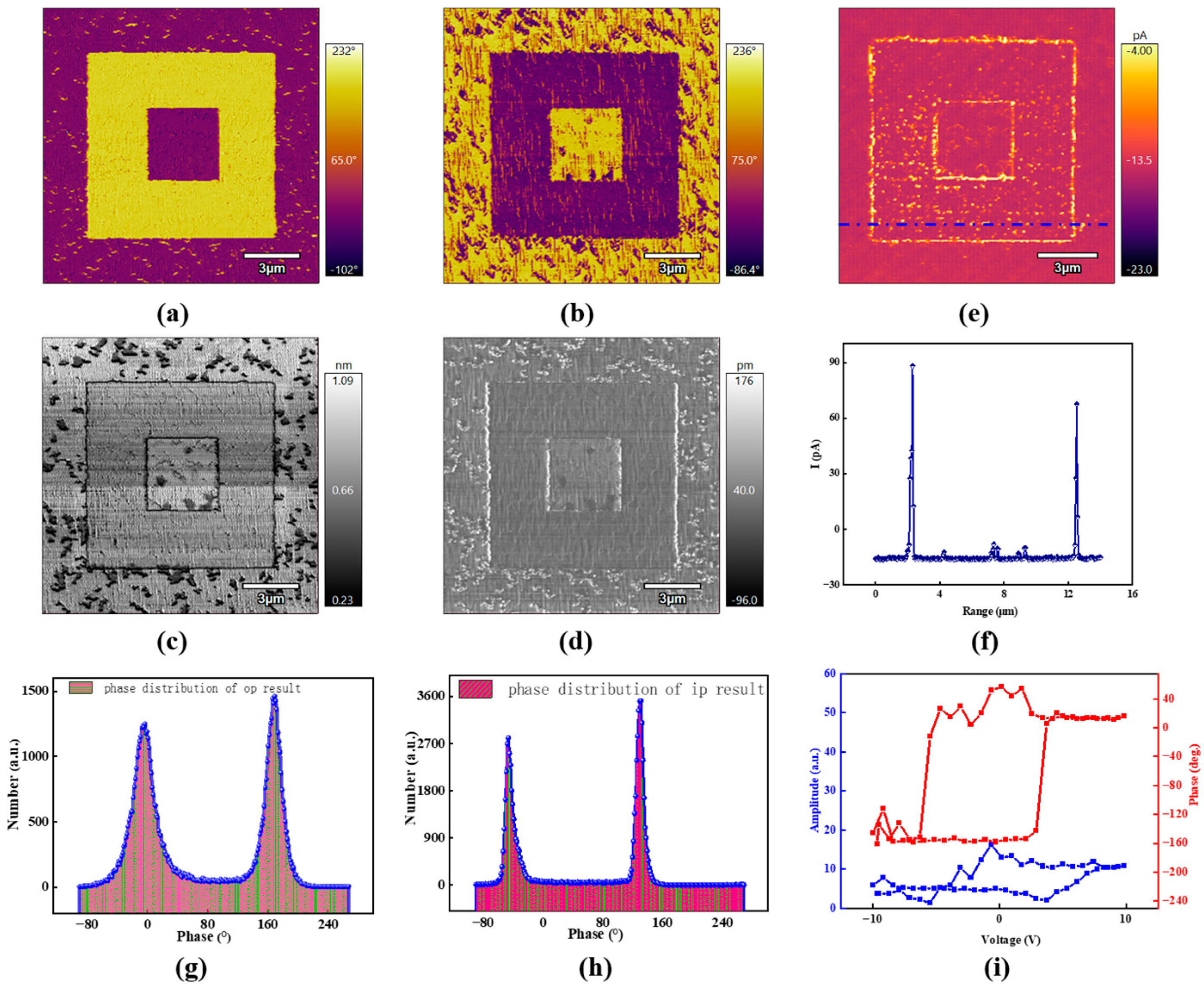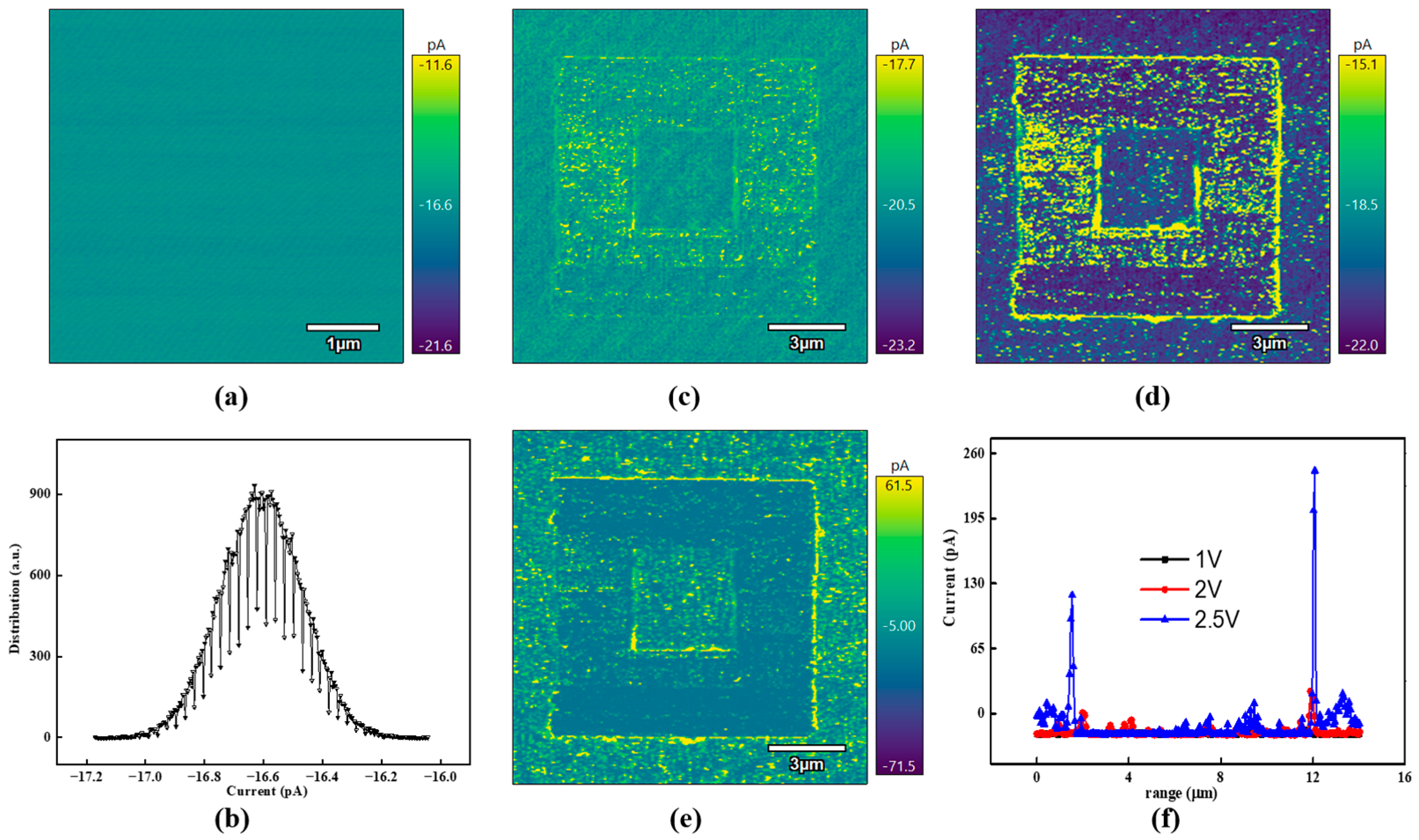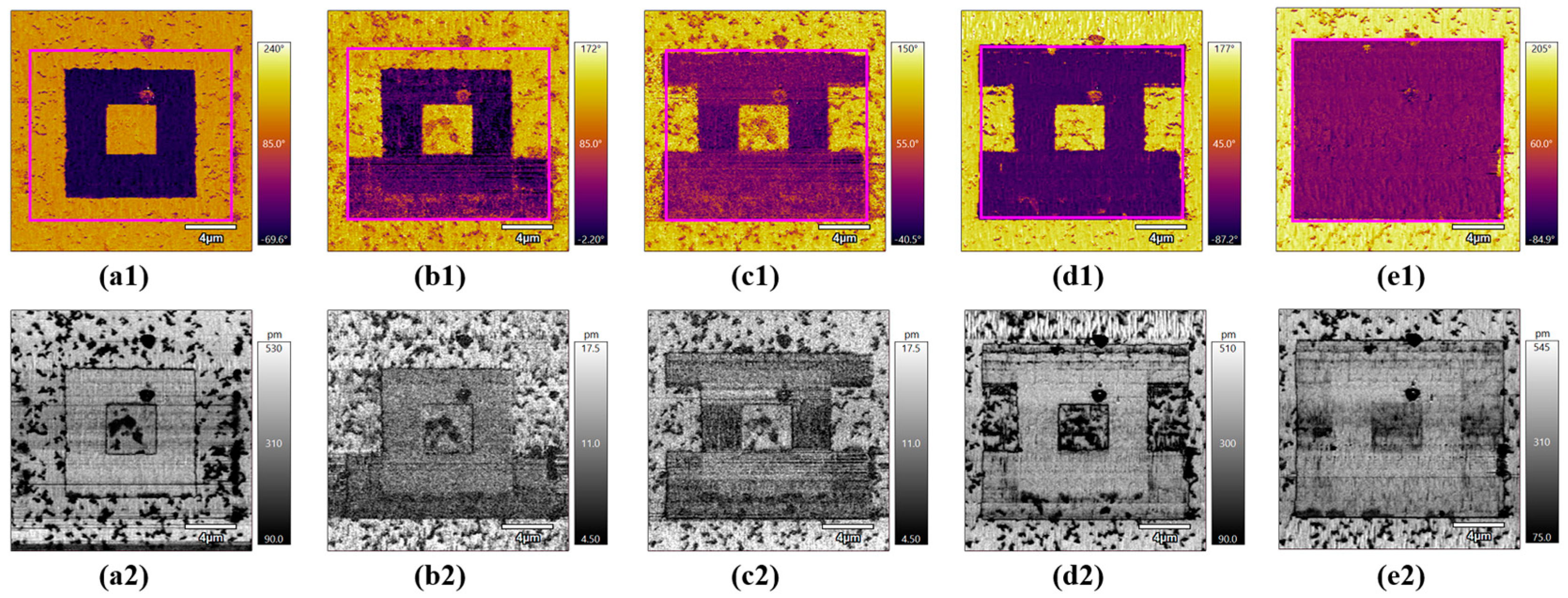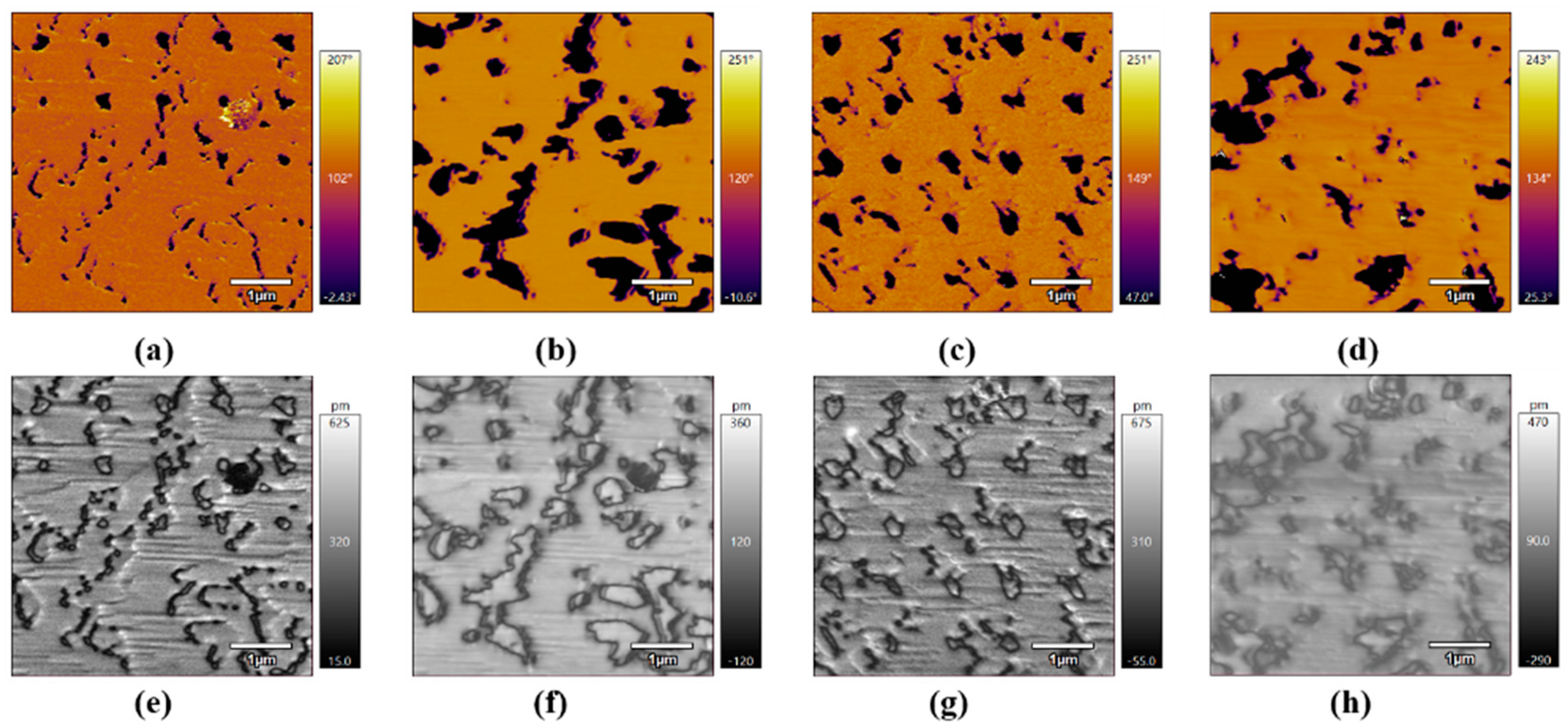Ferroelectric Domain Modulation with Tip-Poling Engineering in BiFeO3 Films
Abstract
1. Introduction
2. Materials and Methods
3. Results
4. Discussion
5. Conclusions
Author Contributions
Funding
Data Availability Statement
Conflicts of Interest
References
- Bencan, A.; Drazic, G.; Ursic, H.; Makarovic, M.; Komelj, M.; Rojac, T. Domain-wall pinning and defect ordering in BiFeO3 probed on the atomic and nanoscale. Nat. Commun. 2020, 11, 1762. [Google Scholar] [CrossRef] [PubMed]
- Butler, K.T.; Frost, J.M.; Walsh, A. Ferroelectric materials for solar energy conversion: Photoferroics revisited. Energy Environ. Sci. 2015, 8, 838–848. [Google Scholar] [CrossRef]
- Chen, Z.; Liu, J.; Qi, Y.; Chen, D.; Hsu, S.L.; Damodaran, A.R.; He, X.; N’Diaye, A.T.; Rockett, A.; Martin, L.W. 180 degrees Ferroelectric Stripe Nanodomains in BiFeO3 Thin Films. Nano Lett. 2015, 15, 6506–6513. [Google Scholar] [CrossRef] [PubMed]
- Liu, Y.; Wang, S.; Chen, Z.; Xiao, L. Applications of ferroelectrics in photovoltaic devices. Sci. China Mater. 2016, 59, 851–866. [Google Scholar] [CrossRef]
- Bhatnagar, A.; Roy Chaudhuri, A.; Heon Kim, Y.; Hesse, D.; Alexe, M. Role of domain walls in the abnormal photovoltaic effect in BiFeO3. Nat. Commun. 2013, 4, 2835. [Google Scholar] [CrossRef]
- Choi, T.; Lee, S.; Choi, Y.J.; Kiryukhin, V.; Cheong, S.W. Switchable ferroelectric diode and photovoltaic effect in BiFeO3. Science 2009, 324, 63–66. [Google Scholar] [CrossRef]
- Hong, S.; Choi, T.; Jeon, J.H.; Kim, Y.; Lee, H.; Joo, H.Y.; Hwang, I.; Kim, J.S.; Kang, S.O.; Kalinin, S.V.; et al. Large resistive switching in ferroelectric BiFeO3 nano-island based switchable diodes. Adv. Mater. 2013, 25, 2339–2343. [Google Scholar] [CrossRef]
- Zhang, F.; Fan, H.; Han, B.; Zhu, Y.; Deng, X.; Edwards, D.; Kumar, A.; Chen, D.; Gao, X.; Fan, Z.; et al. Boosting Polarization Switching-Induced Current Injection by Mechanical Force in Ferroelectric Thin Films. ACS Appl. Mater. Interfaces 2021, 13, 26180–26186. [Google Scholar] [CrossRef]
- Haykal, A.; Fischer, J.; Akhtar, W.; Chauleau, J.Y.; Sando, D.; Finco, A.; Godel, F.; Birkholzer, Y.A.; Carretero, C.; Jaouen, N.; et al. Antiferromagnetic textures in BiFeO3 controlled by strain and electric field. Nat. Commun. 2020, 11, 1704. [Google Scholar] [CrossRef]
- Hong, Z.; Das, S.; Nelson, C.; Yadav, A.; Wu, Y.; Junquera, J.; Chen, L.Q.; Martin, L.W.; Ramesh, R. Vortex Domain Walls in Ferroelectrics. Nano Lett. 2021, 21, 3533–3539. [Google Scholar] [CrossRef]
- Huang, H.-H.; Zhang, Q.; Huang, E.; Maran, R.; Sakata, O.; Ehara, Y.; Shiraishi, T.; Funakubo, H.; Munroe, P.; Valanoor, N. Epitaxial PbZrxTi1−xO3Ferroelectric Bilayers with Giant Electromechanical Properties. Adv. Mater. Interfaces 2015, 2, 1500075. [Google Scholar] [CrossRef]
- Jeon, J.; Kim, K.-H. Evolution of domain structure in PbZr0.52Ti0.48O3 thin film by adding dysprosium. Thin Solid Film 2020, 701, 137940. [Google Scholar] [CrossRef]
- Jiang, A.Q.; Geng, W.P.; Lv, P.; Hong, J.W.; Jiang, J.; Wang, C.; Chai, X.J.; Lian, J.W.; Zhang, Y.; Huang, R.; et al. Ferroelectric domain wall memory with embedded selector realized in LiNbO3 single crystals integrated on Si wafers. Nat. Mater. 2020, 19, 1188–1194. [Google Scholar] [CrossRef] [PubMed]
- Strelcov, E.; Ievlev, A.V.; Jesse, S.; Kravchenko, I.I.; Shur, V.Y.; Kalinin, S.V. Direct probing of charge injection and polarization-controlled ionic mobility on ferroelectric LiNbO3 surfaces. Adv. Mater. 2014, 26, 958–963. [Google Scholar] [CrossRef]
- Li, M.; Yang, S.; Shi, R.; Li, L.; Zhu, R.; Li, X.; Cheng, Y.; Ma, X.; Zhang, J.; Liu, K.; et al. Engineering of multiferroic BiFeO3 grain boundaries with head-to-head polarization configurations. Sci. Bull. 2021, 66, 771–776. [Google Scholar] [CrossRef]
- Liu, L.; Xu, K.; Li, Q.; Daniels, J.; Zhou, H.; Li, J.; Zhu, J.; Seidel, J.; Li, J.F. Giant Domain Wall Conductivity in Self-Assembled BiFeO3 Nanocrystals. Adv. Funct. Mater. 2020, 31, 2005876. [Google Scholar] [CrossRef]
- Maksymovych, P.; Seidel, J.; Chu, Y.H.; Wu, P.; Baddorf, A.P.; Chen, L.Q.; Kalinin, S.V.; Ramesh, R. Dynamic conductivity of ferroelectric domain walls in BiFeO3. Nano Lett. 2011, 11, 1906–1912. [Google Scholar] [CrossRef]
- Zhang, D.; Sando, D.; Sharma, P.; Cheng, X.; Ji, F.; Govinden, V.; Weyland, M.; Nagarajan, V.; Seidel, J. Superior polarization retention through engineered domain wall pinning. Nat. Commun. 2020, 11, 349. [Google Scholar] [CrossRef] [PubMed]
- Chen, X.; Qiao, X.; Zhang, L.; Zhang, J.; Zhang, Q.; He, J.; Mu, J.; Hou, X.; Chou, X.; Geng, W. Temperature dependence of ferroelectricity and domain switching behavior in Pb(Zr0·3Ti0.7)O3 ferroelectric thin films. Ceram. Int. 2019, 45, 18030–18036. [Google Scholar] [CrossRef]
- Meng, J.; Jiang, J.; Geng, W.; Chen, Z.; Zhang, W.; Jiang, A. Domain switching dynamics in ferroelectric-resistive BiFeO3 thin film memories. Jpn. J. Appl. Phys. 2015, 54, 024102. [Google Scholar] [CrossRef]
- Ding, L.; Ji, Y.; Zhang, X.; Wu, M.; Zheng, Y.; Wang, B.; Chen, W. Exotic Quad-Domain Textures and Transport Characteristics of Self-Assembled BiFeO3 Nanoislands on Nb-Doped SrTiO3. ACS Appl. Mater. Interfaces 2021, 13, 12331–12340. [Google Scholar] [CrossRef] [PubMed]
- Park, S.M.; Wang, B.; Das, S.; Chae, S.C.; Chung, J.S.; Yoon, J.G.; Chen, L.Q.; Yang, S.M.; Noh, T.W. Selective control of multiple ferroelectric switching pathways using a trailing flexoelectric field. Nat. Nanotechnol. 2018, 13, 366–370. [Google Scholar] [CrossRef] [PubMed]
- Xu, D.-D.; Ma, R.-R.; Zhao, Y.-F.; Guan, Z.; Zhong, Q.-L.; Huang, R.; Xiang, P.-H.; Zhong, N.; Duan, C.-G. Unconventional out-of-plane domain inversion via in-plane ionic migration in a van der Waals ferroelectric. J. Mater. Chem. C 2020, 8, 6966–6971. [Google Scholar] [CrossRef]
- Qiao, X.; Geng, W.; Sun, Y.; Zheng, D.; Yang, Y.; Meng, J.; He, J.; Bi, K.; Cui, M.; Chou, X. Robust in-plane polarization switching in epitaxial BiFeO3 films. J. Alloys Compd. 2021, 852, 156988. [Google Scholar] [CrossRef]
- Balke, N.; Winchester, B.; Ren, W.; Chu, Y.H.; Morozovska, A.N.; Eliseev, E.A.; Huijben, M.; Vasudevan, R.K.; Maksymovych, P.; Britson, J.; et al. Enhanced electric conductivity at ferroelectric vortex cores in BiFeO3. Nature Phys. 2012, 8, 81–88. [Google Scholar] [CrossRef]
- Rojac, T.; Bencan, A.; Drazic, G.; Sakamoto, N.; Ursic, H.; Jancar, B.; Tavcar, G.; Makarovic, M.; Walker, J.; Malic, B.; et al. Domain-wall conduction in ferroelectric BiFeO3 controlled by accumulation of charged defects. Nat. Mater. 2017, 16, 322–327. [Google Scholar] [CrossRef]
- Peng, R.-C.; Cheng, X.; Ma, J.; Huang, H.; Ma, J.; Chen, L.-Q.; Nan, C.-W. Understanding and predicting geometrical constraint ferroelectric charged domain walls in a BiFeO3 island via phase-field simulations. Appl. Phys. Lett. 2018, 113, 222902. [Google Scholar] [CrossRef]
- Zhang, Y.; Lu, H.; Yan, X.; Cheng, X.; Xie, L.; Aoki, T.; Li, L.; Heikes, C.; Lau, S.P.; Schlom, D.G.; et al. Intrinsic Conductance of Domain Walls in BiFeO3. Adv. Mater. 2019, 31, 1902099. [Google Scholar] [CrossRef]
- Xu, S.-Q.; Zhang, Y.; Guo, H.-Z.; Geng, W.-P.; Bai, Z.-L.; Jiang, A.-Q. Improved Polarization Retention of BiFeO3 Thin Films Using GdScO3 (110) Substrates. Chin. Phys. Lett. 2017, 34, 027701. [Google Scholar] [CrossRef]
- Lu, H.; Wang, B.; Li, T.; Lipatov, A.; Lee, H.; Rajapitamahuni, A.; Xu, R.; Hong, X.; Farokhipoor, S.; Martin, L.W.; et al. Nanodomain Engineering in Ferroelectric Capacitors with Graphene Electrodes. Nano Lett. 2016, 16, 6460–6466. [Google Scholar] [CrossRef]
- Zhu, J.; Huang, F.; Li, Y.; Li, J.; Cheong, S.-W.; Lu, X.; Jin, Y.; Xiao, S. Dynamics and manipulation of ferroelectric domain walls in bismuth ferrite thin films. Natl. Sci. Rev. 2020, 7, 278–284. [Google Scholar]
- Solmaz, A.; Huijben, M.; Koster, G.; Egoavil, R.; Gauquelin, N.; Van Tendeloo, G.; Verbeeck, J.; Noheda, B.; Rijnders, G. Domain Selectivity in BiFeO3Thin Films by Modified Substrate Termination. Adv. Funct. Mater. 2016, 26, 2882–2889. [Google Scholar] [CrossRef]
- Tu, C.-S.; Chen, P.-Y.; Chen, C.-S.; Sea, W.; Chang, R.R. Enhancement of local piezoresponse in samarium and manganese co-doped bismuth ferrite ceramics. J. Alloys Compd. 2020, 815, 152383. [Google Scholar] [CrossRef]




Disclaimer/Publisher’s Note: The statements, opinions and data contained in all publications are solely those of the individual author(s) and contributor(s) and not of MDPI and/or the editor(s). MDPI and/or the editor(s) disclaim responsibility for any injury to people or property resulting from any ideas, methods, instructions or products referred to in the content. |
© 2024 by the authors. Licensee MDPI, Basel, Switzerland. This article is an open access article distributed under the terms and conditions of the Creative Commons Attribution (CC BY) license (https://creativecommons.org/licenses/by/4.0/).
Share and Cite
Qiao, X.; Wu, Y.; Geng, W.; Chou, X. Ferroelectric Domain Modulation with Tip-Poling Engineering in BiFeO3 Films. Micromachines 2024, 15, 1352. https://doi.org/10.3390/mi15111352
Qiao X, Wu Y, Geng W, Chou X. Ferroelectric Domain Modulation with Tip-Poling Engineering in BiFeO3 Films. Micromachines. 2024; 15(11):1352. https://doi.org/10.3390/mi15111352
Chicago/Turabian StyleQiao, Xiaojun, Yuxuan Wu, Wenping Geng, and Xiujian Chou. 2024. "Ferroelectric Domain Modulation with Tip-Poling Engineering in BiFeO3 Films" Micromachines 15, no. 11: 1352. https://doi.org/10.3390/mi15111352
APA StyleQiao, X., Wu, Y., Geng, W., & Chou, X. (2024). Ferroelectric Domain Modulation with Tip-Poling Engineering in BiFeO3 Films. Micromachines, 15(11), 1352. https://doi.org/10.3390/mi15111352






